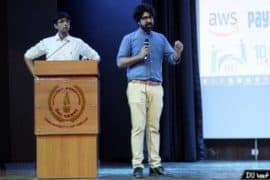The bells of the rickshaw always mingle with the laughter of the students in Delhi University. The sound of their wheels splashing through puddles and myriad hues are all absorbed by the senses in North Campus. From haggling to racing to make it to class on time, it is hard to detach these colourful contraptions from the daily life of a student. An interesting perspective is added when one hears about how it is that rickshaw-wallahs use their life support to express their creativity, and the dynamics involved in such an expression.
Eighteen year old Aman Gupta, who has been driving a rickshaw for a year in North Campus, talks about how it is up to them how they decorates the rickshaw, though they rent it ready-made. Silver gota glistens on the shade of his rickshaw, and the flower printed seats are well polished. He proudly points to the mirror he got attached with his own money, and checks his reflection for a split second. He states the price of the mirror as Rs. 20 and how he saved up Rs. 150 for fresh paint. Twenty-seven year old Umesh Kumar, who has been driving a rickshaw for Thirteen years now, mentions how it’s entirely up to the driver to maintain and decorate the rickshaw after a certain point, and it is their own expenditure as well. Thus, he says, the upkeep of the rickshaw seriously reflects the personality of the driver as the slovenly ones have torn seats and minimal decoration.
He disdainfully signals towards a particularly woebegone rickshaw whose owner sits on it and smokes his beedi. Fifty year old Anil Yadav speaks little and is solely interested in getting a ‘sawari’ and reluctantly answers questions. He claims that a few years ago when he had added some mirror work to his rickshaw, it had been broken at night during a drunken brawl and he had lost a lot of money. He decided then that it did not matter to him what his rickshaw looked like, yet the ripped seat covers and rusting polls had a certain antique appeal that matched his personality.
Hira Lal who is Forty-four (and he claims to be have been around for donkey years) emphasizes that the time when their rickshaws undergo maximum transformation is during election time, when they are paid by student parties to plaster their rickshaws with posters and stickers. He takes me to the repair-man behind Patel Chest, Sabir Ansari who appears to have just one suit case but is a miracle man when it comes to fixtures. He tells me how it’s mostly the younger ones who come to make additions, especially little pictures of Bollywood actresses or bright paint to attract customers along with shouts of ‘shri-ram-daulat-ram-hindu-ramjas.’ He ponders how those who end up earning more, tend to opt for flashier embellishments.
Most rickshaws have ‘Raj’ painted on them. It turns out that he is the owner of all the rickshaws, their ‘maalik’. Mahesh Sethi states that he is moving away from the rickshaw business now that his father (Raj) has passed away.He talks about how the rickshaw seat covers and decorations are made mostly in Rana Pratap Bagh, yet are accessed in Majnu Ka Tilla and Chandni Chowk as well. They had about two to three designers working on accessing the seat covers and shade fabric etc. at all times and the material is mostly locally produced. While choosing the designs he says that maximum emphasis is on decreasing expenditure as well as durability. They mostly use bold designs so that they can stand out and his favourite recently was the one which incorporated the world map in its design. They also tend to use contrasting primary colours for effect, and it is not unusual to see a bold red-rickshaw with parrot green seats traipsing through Kamala Nagar.
Aman is surrounded by a group of rickshaw-wallahs all of whom tell me that they are all limited in their expenditure and that they cannot afford to put in as much effort on their rickshaws because they need to feed their family two meals a day. “Who has the money for such luxuries?” one smirks. It is fairly obvious that financial limitations affect their creative expression. As the multitude of rickshaws flood the streets of Campus, the color and printed vibrance that they add to college life is unique in itself. Perhaps the next time one is haggling for too long, one can think about how those few rupees can be used to add a cheerful dash on the rickshaw and its driver’s life.



Comments are closed.